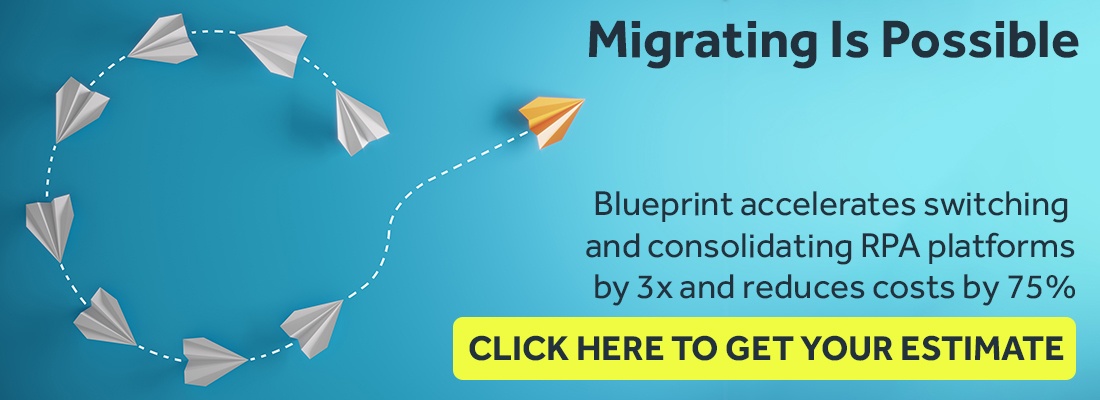The 4 Reasons Some Companies Use a Multi-Platform RPA Strategy
Some key trends are presently emerging in the RPA (robotic process automation) space.
One is RPA platform migrations—the desire for RPA programs to migrate their portfolio of bots to another RPA vendor. The growing motivation to switch RPA tools is based on a multitude of reasons ranging from insufficient returns, complexity, and decreasing the cost of ownership.
The second trend is that many of the organizations and RPA programs we talk to are using multiple RPA platforms for their automation initiatives.
We believed that this practice was a common motivator for migration, and in many cases, it is. The desire to consolidate automation development and deployment into one platform for better oversight, governance, standardization, and control is high. This desire has contributed to a belief that running multiple RPA vendors in the same automation program was not a best practice—it created disconnected and inconsistent automation design and development practices and inflated costs, usually in the form of licensing fees.
However, some companies are actively using multiple RPA tools. Is this the right strategy for you too? Let’s find out!
The 4 Reasons for Using Multiple RPA Platforms
-
Compatibility
Some clear leaders in the RPA market include UiPath, Microsoft Power Automate, Blue Prism, and Automation Anywhere.
With any maturing software market, new vendors will try to enter the game in an effort to gain market share. According to Gartner, with 60 vendors currently in the RPA space, revenues are expected to surpass $2 billion by the end of this year. In the automation market, there is undoubtedly money to be made.
These smaller vendors will focus on niche use cases, and that’s exactly what’s happening.
Organizations may be motivated to onboard new vendors because of ease of use with their enterprise infrastructure. A company’s choice of ERP (Enterprise Resource Planner) is a prime example.
If a company uses SAP, they might want to invest in an additional RPA tool that makes automating processes for SAP (like opening or closing cases, filling in forms, copying and pasting data into SAP, etc.) easier.
In many cases, major software vendors like SAP and Salesforce are developing and providing their own automation capabilities precisely for this reason. They want to be able to capitalize on the RPA market opportunity that’s red hot right now while also delivering expanded feature sets to their customer base as expectations and technology evolves.
-
Specialization
Specialization is another common reason RPA programs are using multiple RPA vendors. Specialization is similar to the compatibility argument, but in this case, specialization refers to the types of processes being automated.
As stated in the previous section, there are emerging vendors that are focusing on specific use cases. We’re seeing RPA platforms being explicitly developed for automating IT, HR, or Finance processes that are turning the right heads.
Redwood is an excellent example of this. It’s an RPA vendor specializing in automating Finance workflows, a department that RPA has had a lot of success in penetrating.
With the RPA software market still in its relative infancy, it’s only natural to suggest that this trend will continue. More specialized vendors will emerge, motivating automation programs to onboard them for increased ease of use and faster RPA delivery.
-
Different Lines of Businesses Have Their Own Preferences
Initially, RPA was driven by specific lines of business such as the Finance & Accounting department, HR, Operations, etc. At the time of implementation, they chose a vendor, or their service integrators chose a vendor that made sense for their specific use case.
Inevitably, IT identified the exponential application and benefit of RPA for their own purposes. What ensued in many organizations is that IT chose a different RPA platform that suited their needs.
With different lines of business unwilling to switch vendors, organizations, and eventually, RPA CoEs (Centers of Excellence), ended up with multiple RPA platforms to contend with. It’s a strategy and arrangement that may have its benefits, but standardization, control, visibility, and governance become increasingly complex when dealing with multiple platforms within one organization.
-
Hedging Bets
While there are clear leaders in the RPA software market, as far as software categories go, RPA is still a relatively new one.
RPA programs and RPA itself is not that mature. Automation teams are still figuring it out, getting their footing, and as a result, are sampling vendors to see which best suits their needs: which is the most cost-effective (in terms of licensing, resources needed, etc.), which has the best time to value in terms of implementation, bot development, bot deployment, which offers the best support terms, boasts the most impressive analytics features, etc.
RPA tools have different capabilities, strengths, weaknesses, and complexities. As a result, RPA programs are still trying to find their fit with the various providers available, and because of that, we think a multi-vendor strategy is here to stay.
With all things considered, there are clear benefits and reasons for taking a multi-platform approach when it comes to automation. But, with such a strategy, greater attention around governance and control is needed. Chiefly, a central, visible location that can house all automations, regardless of the amount of RPA execution platforms you’re using.
That’s something Blueprint can provide.
Blueprint offers a central repository for all your automations regardless of the number of RPA execution tools you use. Because of Blueprint’s bi-directional integrations with all the leading RPA platforms, our solution can ingest all your automated processes and deliver a digital twin in Blueprint.
From there, all automation stakeholders can converge to collaborate on automation design, governance, and change management with total end-to-end visibility on your entire RPA operations.
But, if you’d like to abandon your multi-platform approach and get all your eggs in the same basket, one of our biggest use cases is our RPA Migration Assistant that accelerates bot migrations by 3x at 25% of the manual cost.
Click below and we’ll even give you a no-strings-attached free estimate on a digital workforce migration you might be interested in depending on the size of your bot portfolio and your source and target RPA tools.
Share this
Recent Stories

The Challenges in Switching RPA Tools and How to Overcome Them

Blueprint Launches Solution for RPA Platform Migration, Ending RPA Vendor Lock-In



